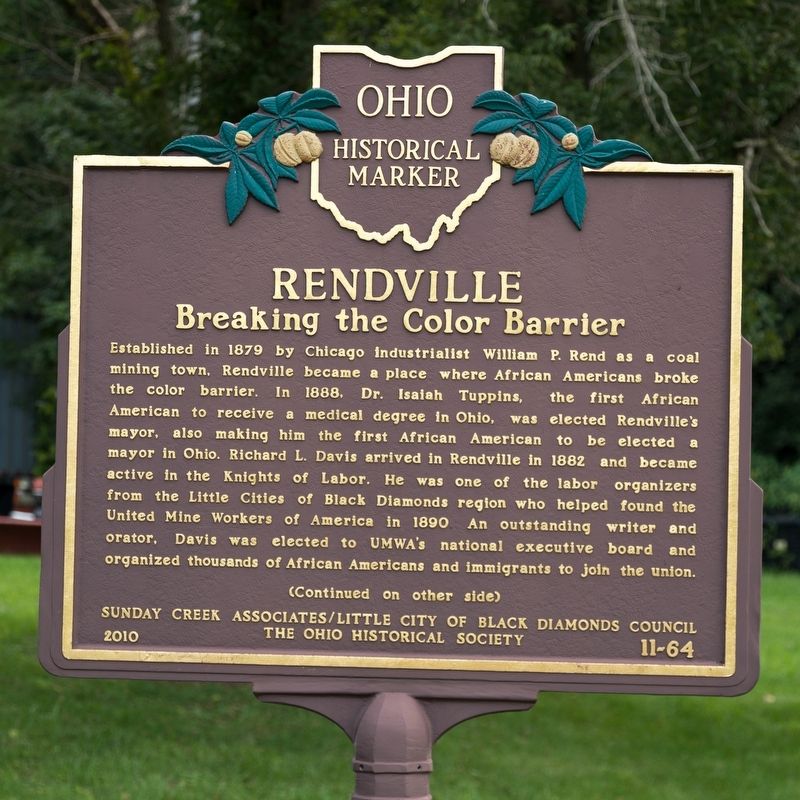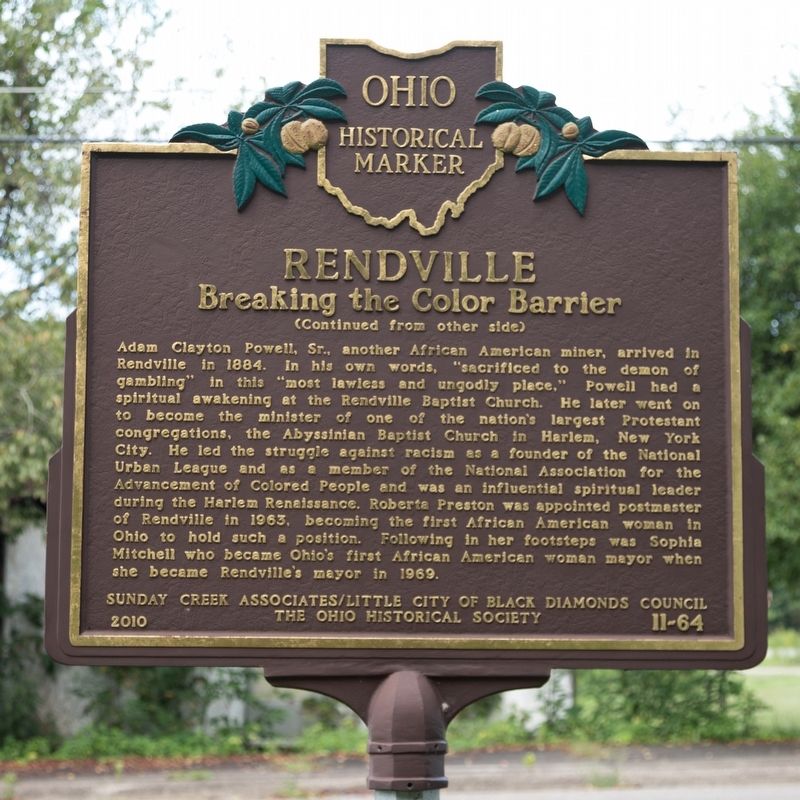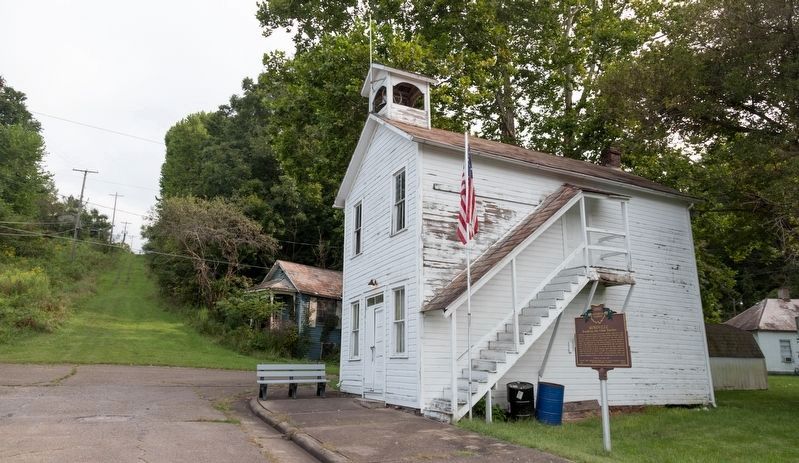Rendville in Perry County, Ohio — The American Midwest (Great Lakes)
Rendville
Breaking the Color Barrier
Established in 1879 by Chicago industrialist William P. Rend as a coal mining town, Rendville became a place where African Americans broke the color barrier. In 1888, Dr. Isaiah Tuppins, the first African American to receive a medical degree in Ohio, was elected mayor, also making him the first African American to be elected a mayor in Ohio. Richard L. Davis arrived in Rendville in 1882 and became active in the Knights of Labor. He was one of the labor organizers from the Little Cities of Black Diamonds region who helped found United Mine Workers of America in 1890. An outstanding writer and orator, Davis was elected to UMWA’s national executive board and organized thousands of African Americans and immigrants to join the union.
Adam Clayton Powell, Sr., another African American miner, arrived in Rendville in 1884. In his own words, “sacrificed to the demon of gambling” in this “most lawless and ungodly place,” Powell had a spiritual awakening at the Rendville Baptist Church. He later went on to become the minister of one of the nation’s largest Protestant congregations, the Abyssinian Baptist Church in Harlem, New York City. He led the struggle against racism as a founder of the National Urban League and as member of the National Association for the Advancement of Colored People and was an influential spiritual leader during the Harlem Renaissance. Roberta Preston was appointed postmaster of Rendville in 1963, becoming the first African American woman in Ohio to hold such a position. Following in her footsteps was Sophia Mitchell who became Ohio’s first African American woman mayor when she became Rendville’s mayor in 1969.
Erected 2010 by Sunday Creek Associates, Little City of Black Diamonds Council and The Ohio Historical Society. (Marker Number 11-64.)
Topics and series. This historical marker is listed in these topic lists: African Americans • Churches & Religion • Industry & Commerce • Labor Unions. In addition, it is included in the Ohio Historical Society / The Ohio History Connection series list. A significant historical year for this entry is 1879.
Location. 39° 37.176′ N, 82° 5.414′ W. Marker is in Rendville, Ohio, in Perry County. Marker is at the intersection of Lower Main Street and Valley Street, on the left when traveling south on Lower Main Street. It is one block east of State Route 13. Main street is no longer continuous. Marker is in the lower portion of town. Touch for map. Marker is at or near this postal address: 6495 Main Street, Corning OH 43730, United States of America. Touch for directions.
Other nearby markers. At least 8 other markers are within 7 miles of this marker, measured as the crow flies. Richard L. Davis: The Sage Of Rendville (a few steps from this marker); Hemlock (approx. 3.6 miles away); Saltlick Township Memorial Park (approx. 6˝ miles away); Knights of Labor Opera House (approx. 6.6 miles away); Shawnee (approx. 6.6 miles away); Welcome to Shawnee and the Little Cities of Back Diamond Region (approx. 6.6 miles away); A Boom Town (approx. 6.6 miles away); Black Diamonds and Bricks (approx. 6.6 miles away).
Also see . . .
1. Rendville has unique history as a coal town. 2015 article by Sis Bowman in the Zanesville Times Recorder. “Jerry Jackson was raised in Rendville and is listed on the rolls as one of the notable people of the town. He was a basketball star and has been given awards in four Halls of Fame. Ohio University still holds the record for going farthest in the NCAA tournament during his time playing there.” (Submitted on August 26, 2018.)
2. Isaiah Tuppins. “Upon receiving his medical degree, Tuppins found employment as a doctor with the Ohio Central Coal Company in Rendville, Ohio, which is located in Perry County. Traditionally, white miners had refused to allow companies to hire African-American miners. William P. Rend, the founder of Rendville and owner of a mine in this community, hired large numbers of African Americans as well as Europeans. Tuppins won election as Rendville’s mayor in 1888, becoming the first African-American man to serve as mayor of any community in Ohio. As mayor, Tuppins had to defend his town from white residents of the nearby community of Corning, Ohio. Corning's residents, who were principally miners, did not like the presence of African Americans in Rendville. In 1888, a mob of Corning whites prepared to descend on Rendville, following the murder of a white Corning man presumably by an African-American man from Rendville. Tuppins convinced Corning law enforcement officials to disperse the mob and to protect the accused man. ” (Submitted on August 26, 2018.)
3. Richard L. Davis. “While on an inspection of working conditions in the mines in the Hocking Valley section of Ohio, UMWA leaders, including Davis, went to the Mercer Hotel in Corning, Ohio. A meeting with Ohio and West Virginia miners was to occur over lunch at the hotel, but the West Virginia miners refused to eat with Davis because of his race. The hotel staff removed Davis from the establishment, and the UMWA leaders and Ohio miners left in protest. Davis filed a complaint with the Ohio government, and the Mercer Hotel became the first Ohio business punished under the state’s anti-discrimination laws.” (Submitted on August 26, 2018, by J. J. Prats of Powell, Ohio.)
4. Powell, Adam Clayton, Sr. “During his youth, Powell lived a reckless life filled with gambling. At the age of 19, Powell experienced a religious conversion to Christianity at a revival meeting.” ... “In 1908, Powell became pastor of Abyssinian Baptist Church in lower Manhattan, New York. His energetic preaching style attracted over 1,500 members. Powell’s conservative social message warned against social immorality, but his liberal activist preaching urged black parishioners to engage in protest against racial discrimination.” (Submitted on August 26, 2018.)
5. Breaking the Color Barrier: Rendville, Ohio. Article in The Soul of Athens produced by Sonja Foster includes photographs. Excerpt:
In October 2010, an Ohio Historical Marker was unveiled to commemorate the story of Rendville and its significance in Ohio history as a place that African-Americans broke the color barrier. The marker stands beside the Town Hall on Main Street. Dr. Frans Doppen, chair of the Department of Teacher Education at Ohio University was, along with his students, instrumental in making it happen. Over a three-year period, students organized fundraisers to pay for the marker.(Submitted on August 26, 2018.)
“Rendville is a little piece of history that needs to be saved,” Doppen said, adding that Rendville’s location right off Route 13 provides people with an opportunity to learn more about the African-American history that took place there.
Founded in July 2015, the Rendville Historic Preservation Society (RHPS) reestablished the Emancipation Day celebration in September which commemorates President Abraham Lincoln issuing a preliminary Emancipation Proclamation on Sept. 22, 1862, which set more than three millionblack slaves free. The RHPS is also working to renovate a donated coal mining house and turning it into a museum, coffee shop and visitor center. It will be located on Main Street and people who visit can learn about Rendville’s rich history.Photographed By J. J. Prats, August 22, 20183. Rendville Town Hall and the Historical MarkerThe Story of Rendville: An Interracial Quest for Community in the Post Civil War Era
The Little Cities website entry
Click for more information.
Additional commentary.
1. Smallest incorporated community in Ohio.
Rendville is the smallest incorporated community in Ohio with a population of 36 as of the 2010 U.S. Census (estimate for 2018 is the same). This little town’s history and former residents played a big role in the story of racial integration/desegregation in Ohio.
— Submitted January 18, 2020, by Mark Hilton of Montgomery, Alabama.
Credits. This page was last revised on January 24, 2023. It was originally submitted on August 26, 2018, by J. J. Prats of Powell, Ohio. This page has been viewed 704 times since then and 93 times this year. Photos: 1, 2, 3. submitted on August 26, 2018, by J. J. Prats of Powell, Ohio.


